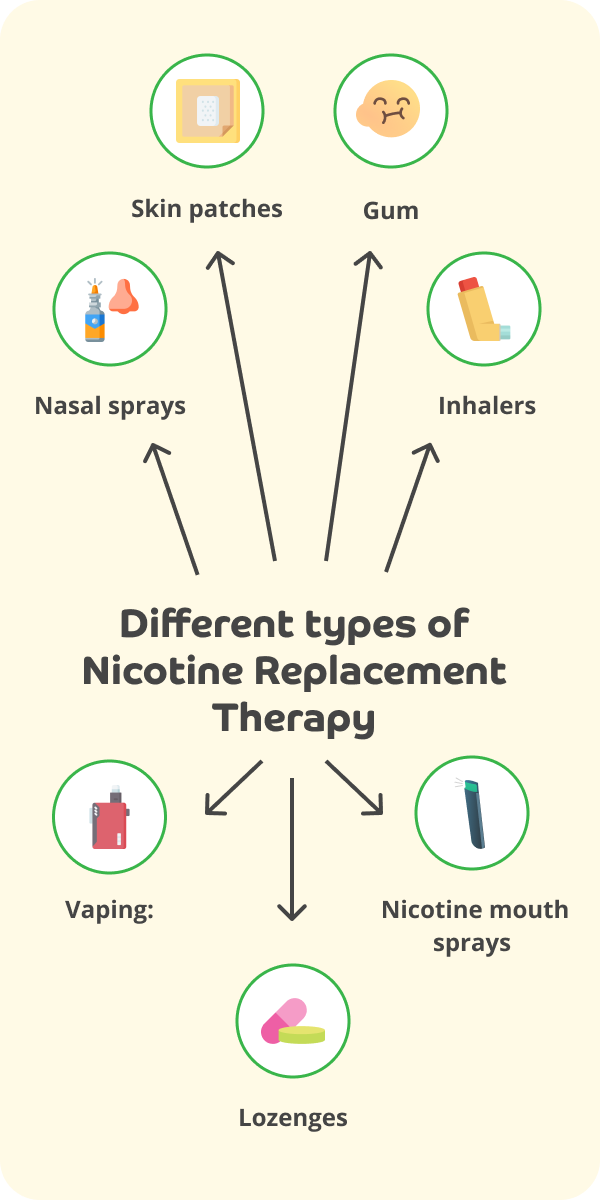Nicotine Replacement Therapy (NRT) is a widely recognised and effective tool for people looking to quit smoking. By delivering controlled doses of nicotine without the harmful chemicals found in cigarettes, NRT can significantly increase the chances of successfully quitting. This article explores how to know if you might benefit from NRT, the various options available, and strategies to ensure its effective use.
Who is Nicotine Replacement Therapy for?

NRT is recommended for those who are physically dependent on nicotine and wish to quit smoking. It’s particularly helpful for people who have tried to quit without help but have struggled with cravings and withdrawal symptoms. According to the NHS, using NRT can double the chances of successfully quitting compared to going cold turkey.
NRT is suitable for most smokers. However, if you’re pregnant, it’s best to stop smoking without using NRTs. If you’re finding quitting hard using willpower alone, NRTs may be used as a last resort, and only with the support of your healthcare professional.
Those with specific health conditions, such as heart disease, kidney or liver problems, should also discuss their options with a doctor.
Options for Nicotine Replacement Therapy – Quit smoking aids that work
NRT is available in several forms, allowing you to choose the method that best suits you and your lifestyle:
- Skin patches: Nicotine patches provide a steady release of nicotine throughout the day. They’re available in various strengths, allowing you to gradually reduce your nicotine intake over time. Patches are easy to use and offer a discreet option if you prefer not to draw attention to your quitting efforts.
- Gum: Nicotine gum allows you to control your nicotine intake while satisfying oral fixation (a repetitive behaviour that involves your mouth, such as biting, sucking, or chewing). It’s available in different flavours and strengths, with the option to chew it when cravings hit. You should follow the recommended chewing instructions to maximise the effectiveness.
- Lozenges: Similar to gum, nicotine lozenges dissolve in your mouth and release nicotine gradually. They’re available in various flavours and forms like oral strips, tablets, and microtabs that dissolve under your tongue. They can be a convenient option for those who’d rather not to chew.
- Inhalers: Nicotine inhalers mimic the hand-to-mouth action of smoking, which can help combat behavioural aspects of smoking addiction. They even look like plastic cigarettes. You can inhale a vaporised form of nicotine, providing a quick relief from cravings.
- Nasal sprays: Nasal sprays deliver nicotine quickly through the nasal membranes in your nose, offering fast relief for sudden cravings. This method may be suitable if you need immediate support during challenging moments.
- Nicotine mouth sprays: These sprays provide nicotine withdrawal relief fast after only one to two sprays by delivering a small nicotine dose directly into your mouth, where it’s absorbed through the lining of your cheeks and gums, quickly entering your bloodstream.
Vaping: While not officially classified as NRT, some people find vaping to be a helpful alternative as they move away from smoking. E-cigarettes can provide a similar hand-to-mouth action and sensory experience, although users should be aware of the need for responsible use and the potential health risks involved.
Current evidence suggests that vaping poses far fewer risks than those linked with smoking, exposing users to fewer toxins and at lower levels. However, it’s already established that vaping can cause inflammation in the airways, and people with asthma have reported to Asthma + Lung UK that vapes can trigger their condition.
Research is still ongoing, and the long-term effects are largely unknown, but results of early studies do reveal respiratory, neurological, and cardiovascular effects. Research is also continuing to better understand vaping’s impact on children and young people. Non-smokers or young people under 18 shouldn’t start vaping, with the government banning the sale or supply of single-use / disposable vapes in June 2025 in a bid to protect children’s health and the environment.
The healthiest option is to steer clear of both smoking and vaping, and if you choose to use vaping as a quit smoking tool, try to eventually stop vaping as well.

Common questions around Nicotine Replacement Therapy:

1. What is the most effective nicotine replacement therapy?
According to the NHS, research has shown that all the different types of NRTs listed above can be effective. Each one has its own merits and the one that’ll suit you best will depend on your personal tastes, ages, whether you’re pregnant or breastfeeding and any medical conditions you have. For this reason, it’s best to speak to your GP or an NHS stop smoking adviser for recommendations.
2. Can you quit smoking without nicotine replacement?
While anything is possible, chances are NRT is likely to play an important role in your stop smoking journey. This is because it can effectively combat the addiction itself. Evidence shows that it’s most effective if used together with support from an NHS Stop Smoking Service (see below).
3. How long does nicotine replacement therapy take to work?
Some NRT, like a spray, inhaler, gum or lozenge, provide quick nicotine withdrawal relief. Others, like patches provide slow and steady relief. The NHS advises using as many types of NRT as you feel you need to help you combat your cravings. When you feel the time is right, you can gradually reduce your dose and eventually stop. It’s recommended that NRTs are used for around 3 months or for as long as they’re necessary to help you stop smoking.
4. What are the side effects of Nicotine Replacement Therapy?
The NHS says possible side effects of using NRT can include:
- skin irritation when using patches
- irritation to your nose, throat or eyes when using a nasal spray
- difficulty sleeping, sometimes with vivid dreams
- an upset stomach
- dizziness
- headaches
Although the possibility of these may not seem pleasant, it’s important to note that these side effects are usually mild and are far outweighed by the health-damaging effects of smoking. But if you’re suffering particularly badly from side-effects, contact your GP as the dose or type of your NRT may need to be adjusted.
5. What is the best way to quit smoking without gaining weight?
As mentioned above, all the different types of NRTs can be effective at helping you quit smoking. You’ll see throughout this article that a combination of professional Stop Smoking Support Services, slow and fasting acting NRTs and nicotine-free medicines is often the best way to quit smoking.
Nicotine in cigarettes can help limit your appetite, and some people may gain some weight after quitting. Your body burns calories slower after quitting too, which can also contribute to weight gain. Try not to worry, as this is perfectly normal. Regular exercise may prevent about half the weight gain expected after a year of stopping smoking.
Eating nourishing meals made from wholefoods and getting active can help curb weight gain. Some types of NRTs can also help manage weight gain by helping your body burn calories faster and reducing your appetite.
How to quit smoking for good with Nicotine Replacement Therapy
To maximise the effectiveness of NRT, consider the following strategies:
- Create a Quit Plan: Establishing a clear quit plan can enhance commitment and provide a roadmap for success. This plan should include a quit date to work towards, a list of your personal triggers, and strategies for managing cravings.
- Combine different types of NRTs: For improved results, consider combining different forms of NRT. For instance, using a nicotine patch for steady relief while having gum or lozenges on hand for sudden cravings can be particularly effective.
- Follow guidelines: Stick to the recommended dosage and instructions that come with each NRT product. Overuse can lead to increased side effects, while underuse may not adequately address cravings.
- Monitor progress: Keep track of your progress and celebrate milestones, whether it’s a day, a week, or a month smoke free – doing so can reinforce motivation.
- Use support services: NRT isn’t the complete stop smoking solution. Becoming smoke free is a two-fold process: tackling the addiction (which is where NRT come in) and changing your behaviour around smoking (such having ways to cope with your personal triggers, and changing your routines).
Engaging with local Stop Smoking Services, the NHS Smokefree Helpline (free to call 0300 123 1044 and available in England) or online support groups can help compliment the use of NRTs=. The NHS provides a range of resources, including helplines and cessation programs, to assist you with your quitting journey and help you tackle the behaviour change aspect of becoming smoke free. - Stay positive: It may be a cliché and seem like easier said than done, but quitting smoking is a journey filled with both challenges and victories. Maintaining a positive mindset can help navigate the ups and downs of the process. Reminding yourself of the benefits of being smoke free can also spur you on.

It’s not just about combining different types of NRTs and combining NRT with other stop smoking strategies, such as those around behaviour change. Research shows that smokers who use a combination of nicotine-free medicines and NRT are over 5 times more likely to successfully quit. Nicotine-free medicines can help you quit smoking by blocking the effects of nicotine in your brain, making smoking seem less enjoyable. These can be prescribed by your GP or a local Stop Smoking Service.
Nicotine Replacement Therapy is a vital resource if you’re looking to quit smoking. By understanding who NRT is for, exploring the available options, and implementing strategies for success, you can significantly increase your chances of achieving a smoke-free life. Remember, quitting smoking is a process, and with the right tools and support, a healthier future is within your grasp.
For more information and support on quitting smoking, consider the following resources:
- NHS: Stop Smoking Treatments
- Smokefree.gov: Using Nicotine Replacement Therapy
- NHS Inform: Stop Smoking Medication
If you haven’t already, downloading the Evergreen Life app can help you understand more about your health and wellbeing and how to support them.
- Facebook (n.d.) Smokefree Quit Smoking Support Group. [online] Available here.
- Gov.uk (2025) 10-year study to shed light on youth vaping. [online] Available here.
- Gov.uk (2025) Guidance Single-use vapes ban: what businesses need to do. [online] Available here.
- Hamann SL, Kungskulniti N, Charoenca N, et al. (2023) Electronic Cigarette Harms: Aggregate Evidence Shows Damage to Biological Systems. Int. J. Environ Res Public Health. 20(19): 6808. (doi: 10.3390/ijerph20196808).
- HSE (2025) Nicotine mouth spray. [online] Available here.
- NHS Better Health (n.d.) Find the best stop-smoking products for you. [online] Available here.
- NHS Better Health (n.d.) Find your local Stop Smoking Service. [online] Available here.
- NHS Better Health (n.d.) Get a free Personal Quit Plan. [online] Available here.
- NHS Better Health (n.d.) How to help someone quit smoking. [online] Available here.
- NHS Better Health (n.d.) Quit Smoking with nicotine-free medicines. [online] Available here.
- NHS Better Health (n.d.) Quit with Nicotine Replacement Therapies (NRTs). [online] Available here.
- NHS Better Health (n.d.) What could happen when you quit smoking. [online] Available here.
- NHS Inform (2025) Stop smoking medication. [online] Available here.
- NHS Inform (n.d.) Vaping addiction soon takes hold. [online] Available here.
- NHS Mersey Care NHS Foundation Trust (2023) Nicotine Gum. [online] Available here.
- Oxfordshire County Council (n.d.) Stopping smoking without putting on weight. [online] Available here.
- Triggle N. (2025) Disposable vape ban begins – but will it have an impact? [online] Available here.





